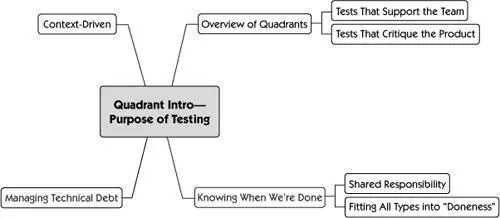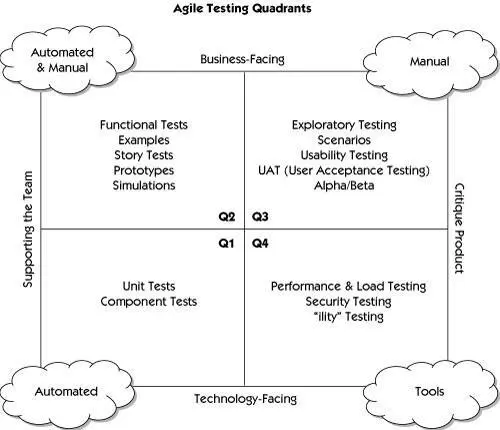Crispin, Lisa - Agile Testing - A Practical Guide for Testers and Agile Teams
Здесь есть возможность читать онлайн «Crispin, Lisa - Agile Testing - A Practical Guide for Testers and Agile Teams» весь текст электронной книги совершенно бесплатно (целиком полную версию без сокращений). В некоторых случаях можно слушать аудио, скачать через торрент в формате fb2 и присутствует краткое содержание. Год выпуска: 2008, Издательство: Addison-Wesley Professional, Жанр: Старинная литература, на английском языке. Описание произведения, (предисловие) а так же отзывы посетителей доступны на портале библиотеки ЛибКат.
- Название:Agile Testing: A Practical Guide for Testers and Agile Teams
- Автор:
- Издательство:Addison-Wesley Professional
- Жанр:
- Год:2008
- ISBN:нет данных
- Рейтинг книги:4 / 5. Голосов: 1
-
Избранное:Добавить в избранное
- Отзывы:
-
Ваша оценка:
- 80
- 1
- 2
- 3
- 4
- 5
Agile Testing: A Practical Guide for Testers and Agile Teams: краткое содержание, описание и аннотация
Предлагаем к чтению аннотацию, описание, краткое содержание или предисловие (зависит от того, что написал сам автор книги «Agile Testing: A Practical Guide for Testers and Agile Teams»). Если вы не нашли необходимую информацию о книге — напишите в комментариях, мы постараемся отыскать её.
Agile Testing: A Practical Guide for Testers and Agile Teams — читать онлайн бесплатно полную книгу (весь текст) целиком
Ниже представлен текст книги, разбитый по страницам. Система сохранения места последней прочитанной страницы, позволяет с удобством читать онлайн бесплатно книгу «Agile Testing: A Practical Guide for Testers and Agile Teams», без необходимости каждый раз заново искать на чём Вы остановились. Поставьте закладку, и сможете в любой момент перейти на страницу, на которой закончили чтение.
Интервал:
Закладка:
 Traditional quality processes and process improvement models, such as SAS 70 audits and CMMI standards, can coexist with agile development and testing. Teams need to be open to thinking outside the box and work together to solve their problems.
Traditional quality processes and process improvement models, such as SAS 70 audits and CMMI standards, can coexist with agile development and testing. Teams need to be open to thinking outside the box and work together to solve their problems.
Part III The Agile Testing Quadrants
Software quality has many dimensions, each requiring a different testing approach. How do we know all the different types of tests we need to do? How do we know when we’re “done” testing? Who does which tests and how? In this part, we explain how to use the Agile Testing Quadrants to make sure your team covers all needed categories of testing.
Of course, testing requires tools, and we’ve included examples of tools to use, strategies for using those tools effectively, and guidelines about when to use them. Tools are easier to use when used with code that’s designed for testability. These concerns and more are discussed in this part of the book.
Chapter 6 The Purpose of Testing

Why do we test? The answer might seem obvious, but in fact, it’s pretty complex. We test for a lot of reasons: to find bugs, to make sure the code is reliable, and sometimes just to see if the code’s usable. We do different types of testing to accomplish different goals. Software product quality has many components. In this chapter, we introduce the Agile Testing Quadrants. The rest of the chapters in Part III go into detail on each of the quadrants. The Agile Testing Quadrants matrix helps testers ensure that they have considered all of the different types of tests that are needed in order to deliver value.
The Agile Testing Quadrants
In Chapter 1, “What Is Agile Testing, Anyway?,” we introduced Brian Marick’s terms for different categories of tests that accomplish different purposes. Figure 6-1 is a diagram of the agile testing quadrants that shows how each of the four quadrants reflects the different reasons we test. On one axis, we divide the matrix into tests that support the team and tests that critique the product. The other axis divides them into business-facing and technology-facing tests.
Figure 6-1 Agile Testing Quadrants

The order in which we’ve numbered these quadrants has no relationship to when the different types of testing are done. For example, agile development starts with customer tests, which tell the team what to code. The timing of the various types of tests depends on the risks of each project, the customers’ goals for the product, whether the team is working with legacy code or on a greenfield project, and when resources are available to do the testing.
Tests that Support the Team
The quadrants on the left include tests that support the team as it develops the product. This concept of testing to help the programmers is new to many testers and is the biggest difference between testing on a traditional project and testing on an agile project. The testing done in Quadrants 1 and 2 are more requirements specification and design aids than what we typically think of as testing.
Quadrant 1
The lower left quadrant represents test-driven development, which is a core agile development practice.
Unit tests verify functionality of a small subset of the system, such as an object or method. Component tests verify the behavior of a larger part of the system, such as a group of classes that provide some service [Meszaros, 2007]. Both types of tests are usually automated with a member of the xUnit family of test automation tools. We refer to these tests as programmer tests, developer-facing tests, or technology-facing tests. They enable the programmers to measure what Kent Beck has called the internal quality of their code [Beck, 1999].
A major purpose of Quadrant 1 tests is test-driven development (TDD) or test-driven design. The process of writing tests first helps programmers design their code well. These tests let the programmers confidently write code to deliver a story’s features without worrying about making unintended changes to the system. They can verify that their design and architecture decisions are appropriate. Unit and component tests are automated and written in the same programming language as the application. A business expert probably couldn’t understand them by reading them directly, but these tests aren’t intended for customer use. In fact, internal quality isn’t negotiated with the customer; it’s defined by the programmers. Programmer tests are normally part of an automated process that runs with every code check-in, giving the team instant, continual feedback about their internal quality.
Quadrant 2
The tests in Quadrant 2 also support the work of the development team, but at a higher level. These business-facing tests, also called customer-facing tests and customer tests, define external quality and the features that the customers want.
Like the Quadrant 1 tests, they also drive development, but at a higher level. With agile development, these tests are derived from examples provided by the customer team. They describe the details of each story. Business-facing tests run at a functional level, each one verifying a business satisfaction condition. They’re written in a way business experts can easily understand using the business domain language. In fact, the business experts use these tests to define the external quality of the product and usually help to write them. It’s possible this quadrant could duplicate some of the tests that were done at the unit level; however, the Quadrant 2 tests are oriented toward illustrating and confirming desired system behavior at a higher level.
Chapter 8, “Business-Facing Tests that Support the Team,” explains business conditions of satisfaction.
Most of the business-facing tests that support the development team also need to be automated. One of the most important purposes of tests in these two quadrants is to provide information quickly and enable fast troubleshooting. They must be run frequently in order to give the team early feedback in case any behavior changes unexpectedly. When possible, these automated tests run directly on the business logic in the production code without having to go through a presentation layer. Still, some automated tests must verify the user interfaces and any APIs that client applications might use. All of these tests should be run as part of an automated continuous integration, build, and test process.
There is another group of tests that belongs in this quadrant as well. User interaction experts use mock-ups and wireframes to help validate proposed GUI (graphical user interface) designs with customers and to communicate those designs to the developers before they start to code them. The tests in this group are tests that help support the team to get the product built right but are not automated. As we’ll see in the following chapters, the quadrants help us identify all of the different types of tests we need to use in order to help drive coding.
Some people use the term “acceptance tests” to describe Quadrant 2 tests, but we believe that acceptance tests encompass a broader range of tests that include Quadrants 3 and 4. Acceptance tests verify that all aspects of the system, including qualities such as usability and performance, meet customer requirements.
Using Tests to Support the Team
Читать дальшеИнтервал:
Закладка:
Похожие книги на «Agile Testing: A Practical Guide for Testers and Agile Teams»
Представляем Вашему вниманию похожие книги на «Agile Testing: A Practical Guide for Testers and Agile Teams» списком для выбора. Мы отобрали схожую по названию и смыслу литературу в надежде предоставить читателям больше вариантов отыскать новые, интересные, ещё непрочитанные произведения.
Обсуждение, отзывы о книге «Agile Testing: A Practical Guide for Testers and Agile Teams» и просто собственные мнения читателей. Оставьте ваши комментарии, напишите, что Вы думаете о произведении, его смысле или главных героях. Укажите что конкретно понравилось, а что нет, и почему Вы так считаете.












